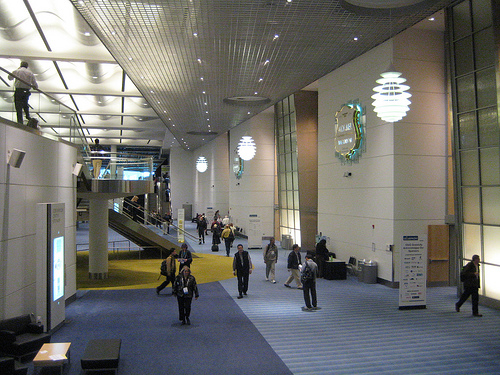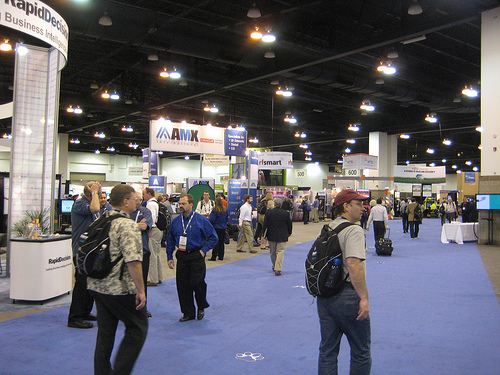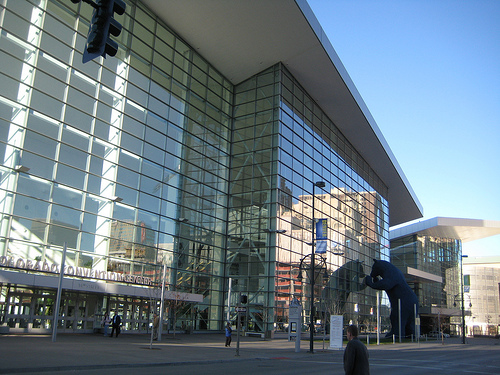Collaborate'08 Days 2 and 3
I'm currently sitting in the wireless hotspot area of the Denver Convention Center (next to Alex Gorbachev, funnily enough) waiting for the Hyperion Tools "What's New and What's Coming" session at 11am. As I've got a few minutes spare I thought I'd jot down some notes on the sessions I went to yesterday and today.
The first session I went to yesterday was a bit of a diversion from the BI sessions I've been mostly going to. To be honest, I've been a bit disappointed with the BI sessions so far - a lot of them have been by the same speakers on more or less the same subject, quite a few are just the Oracle slides with their own company brandings, and the "expert-level" sessions have been fairly basic. There's been a few exceptions - Dan Vlamis' talk comparing Essbase and Oracle OLAP was good, so was the Edward Roske one on Essbase internals - but so far I've been a bit disappointed. Let's hope today and tomorrow's go a bit better.
Anyway, the first session I went to was originally billed as being by Hotsos, but in the end was by Method R, who are of course the spin-off company founded by Cary Millsap who's recently left Hotsos. Method R (the name is taken from the name of the methodology described in the book "Optimizing Oracle Performance") look like they're taking over the development of Method R and the tools around it, and the session itself was good and centered around the idea that the advisors in Oracle 10g and 11g are useful, but you really need to know how they work and how you'd diagnose problems if you didn't have them to hand. It was interesting to hear a Method R presentation given by someone other than Cary, also it was nice to think about something other than BI for an hour or so.
After the Method R presentation was probably the presentation that I've found most useful over the conference so far. It was on enabling real-time data integration using Oracle Change Data Capture, Oracle Database Change Notification and Java messaging, and was of particular interest to me as CDC is something many customers have asked us about. I set up a CDC demo system a couple of years ago - this page on our blog is one of our most popular in terms of page requests - but I've not used it in production, this presentation took CDC on one step further and coupled it with Database Change Notification, a feature that's been in the Oracle database since 9i or 10g and provides mid-tier applications that provide a cache within notifications as to when data has changed. The session talked about a scenario where they had one application running on Oracle that had CDC enabled on it(asynchronous hotlog, which is how we'd set it up), DCN was used to notify the other application that data was waiting, and Java messaging was used to provide the data to the application. DCN can also inform the mid-tier application that the database is up, down or whatever, I'd never heard of this feature but it certainly sounds useful. There were a whole bunch of questions at the end, my one was around resilience, i.e. if the streams subsystem goes down, how easy was it to restart it (reasonably, but there was a lot of learning to do up-front on how this works) and whether any transactions ever got lost (answer: no, it always catches up with itself if streams goes down, the only problem seems to be that CDC seems fairly sensitive to memory issues and so on and will just stop propagating if resources are low). Based on this one bit of good advice was to make sure you build a mechanism to monitor the stream subsystem, if you're using it on a project make sure you create a new database with CDC and streams (and Java) enabled right from the off rather than try and retrofit it to your existing database, and give CDC and streams a thorough shakedown before you try and add your source application to the new database.
After the CDC and DCN talk was another one I was looking forward to, but in the end found disappointing. It was on "Robust ETL using Oracle Warehouse Builder" and was from the guys at Verisign, with the database being ETL'd holding all the .COM and .NET registrations for the world and was hence rather large. We've delivered a similar talk at the last UKOUG conference - slides here - and whilst many of the recommendations were the same - keep your mappings simple, use separate repositories for each environment, use OMB scripting to automate deployment and so on - the problem was that their presentation was based on OWB 10.1 rather that 10.2, which has been out in production for around a couple of years now and is probably the version of OWB that's most often used by customers now. Several of the recommendations, around say how to handle SCD2 mappings, how to handle errors and so on, were just out of date now and it'd have been better to hear, say, a comparison of manually handling SCD2s vs. the in-built handling of these in OWB10gR2, or manual handling of errors vs. using data rules and the data quality option - in the end I felt for the speakers as it was a well thought out talk, but just not all that relevant now that most people are on OWB10gR2.
And that was more or less it for the second day of Collaborate, at least in terms of sessions. In the evening I hooked up with Nicholas Bonnet, one of the Oracle Real Time Decisions product managers, some RTD partners and customers and also Mike Donahoe (BI Publisher product manager) and Matt Bedin (OBIEE product manager) and went downtown for something to eat, then it was back home, catch up with some emails and get ready for today.
Today's first session was on the unstructured data support in Oracle 11g, again my interest in this is around the upcoming DW seminars I'm going to do for Oracle University - one of the areas I want to try and cover off in these is adding unstructured, spatial and multimedia data to your warehouse, so this was a useful session. An area I really must try and get in to is adding spatial and map data to OBIEE, you can add maps and the like to OBIEE now but in 11g this will be a standard feature of the tool, linking this back to the Spatial Option, or even the Locator feature which is of course free, in the Oracle database seems a useful thing to do. Keep an eye on the blog for more on this later on.
After that was a product update talk on the Hyperion tools. I seem to have missed most of the product update sessions at Collaborate this year - there was a Joe Thomas (BI product marketing) talk earlier in the week, and annoyingly the main Oracle BI product management update tomorrow is on at the same time as Pete's talk - but the Hyperion one was useful, both in terms of news on Hyperion Workspace / OBIEE integration (this is due in the EPM 11.1.1 release, previously known as the Kennedy release, or 9.5, which will also need the OBIEE 10.1.3.4 release, both of which are apparently due around June this year), and news on the Essbase Studio (the replacement for Essbase Administration Services and Essbase Integration Services) which will also support OBIEE logical models as a data source (which doesn't seem to work with the current release of EIS and OBIEE, see this blog post for details).
Anyway, the last session for me today will be the BIWA panel session on whether data warehouse appliance vendors are relevant any more, after that I'm taking the afternoon off and popping down the shops, then meeting up with some of the ODTUG people for something to eat later on.


